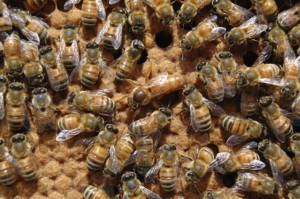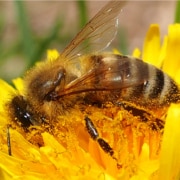April Happenings in the Honeybee Hive
Tips for Pollinators
By Engrid Winslow

Image by Matthew Greger from Pixabay
Beginning in March, as the days lengthen and temperatures begin to warm (at least some of the time!) the bees are starting to raise brood again. April means the delivery of packages and nucs and towards the end of the month established overwintered honeybee hive begins to think of swarming. This is a very busy time for beekeepers and bees. With the vagaries of winter, some early pollen sources may not materialize and all good stewards of the bees will put sugar water and pollen patties in their hives. Pollen is critical in raising healthy brood and March is the time when the colonies are running out of the nectar and pollen they stored in the fall for surviving all winter. Losing a honeybee hive in the early spring can be caused by starvation although all factors such as mite loads, insecticidal poisoning and other issues should also be considered and evaluated.
As spring creeps ever closer, the most abundant sources of pollen and nectar are available during this time. Brood rearing continues in earnest and beekeepers must watch carefully for signs of swarming. Many beekeepers are eager to add to their hives by capturing swarms and add their names to lists with local and state beekeepers associations. (The swarm hotline number in Colorado if you spot a swarm is 1-844-spy- bees, 1-844-779-2337). Classic signs of swarming include large numbers of bees “bearding” or gathering on the outside of the hive. It’s getting crowded in the hive.

Image by Franz Schmid from Pixabay
Inside a honeybee hive that is beginning to swarm a new Queen is being raised. Queen larvae form in a peanut-shaped cell that is much larger than the cell used to raise worker bees and drones. They are usually on the bottom or sticking off the side of a frame. Once the Queen cells form, the bees are already committed to swarming and half of the colony (mostly newly hatched workers who can help the most with producing wax for the honeycomb at the new location) will leave with the older Queen. The new queen is left behind but must leave the hive to fly into the “drone zone” for mating, return to the hive and begin laying eggs. Beekeepers can prevent swarming by “splitting” their hives. This involves removing a few frames with capped brood and plenty of “nurse bees” to take care of the newly hatched brood into a new hive body. Some of the honey stores and pollen should also be placed in the new hive. Some beekeepers move a capped queen cell with a larva inside to the new hive and others purchase a mated queen from a beekeeper in the queen-rearing business.
For more information about swarming check out these past blogs: www.bbbseed.com/honey-bee-swarms/ and www.bbbseed.com/19613-2/.


I enjoyed this educational article. It makes me want to have a bee hive! ????Since I live in a small town on a crowded court, I don’t think my neighbors would be too happy.